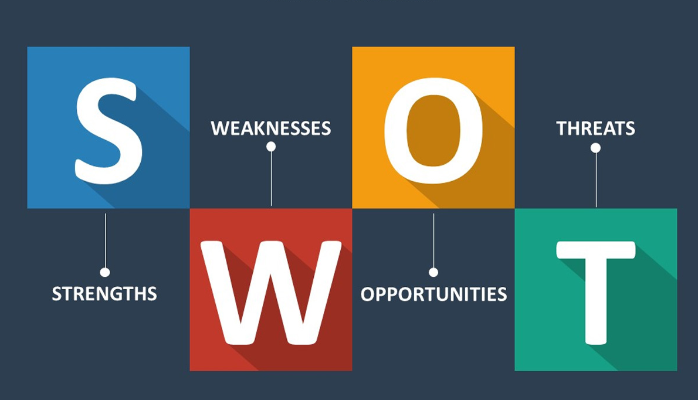
Business Owners are confronted with fierce competition day in and day out. The ever-changing dynamics of modern business warrant vigilant Business Owners to review and reshuffle their business strategy. Here, SWOT ANALYSIS serves as a potent tool to recast strategic plans and their concomitant implementation.
Connotation Of SWOT Analysis
SWOT stands for Strengths, Weaknesses, Opportunities, and Threats.
SWOT Analysis is a technique for assessing these four aspects of the business.
SWOT Analysis is a tool that can help to:
- Analyze what a company does best right now.
- Devise a successful strategy for the future.
- Uncover areas of the business that are holding back.
A SWOT Analysis examines both Internal and External Factors – that is, what is going on inside and outside any business enterprise.
A SWOT Analysis Matrix

SWOT Analysis is a technique for assessing the performance, competition, risk, and potential of a business. Also, it takes into account a part of a business such as a product line or division, an industry, or other entity.
Strengths
Strengths describe what an organization excels at and what separates it from the competition:
- A Strong Brand
- Loyal Customer Base
- A Strong Balance Sheet
- Unique Technology
- USP (Unique Selling Proposition)
Weaknesses
Weaknesses stop an organization from performing at its optimum level. They are areas where the business needs to improve to remain competitive:
- A Weak Brand
- Higher Than Average Turnover
- High Levels of Debt
- An Inadequate Supply Chain, or Lack of Capital.
Opportunities
Opportunities refer to favorable external factors that could give an organization a competitive advantage.
Threats
Threats refer to factors that have the potential to harm an organization.

How To Use A SWOT Analysis
Internal
Potential questions to list internal factors are:
- (Strength) What are we doing well?
- (Strength) What is our strongest asset?
- (Weakness) What are our detractors?
- (Weakness) What are our lowest-performing product lines?
External
Potential questions to list external factors are:
- (Opportunity) What trends are evident in the marketplace?
- (Opportunity) What demographics are we not targeting?
- (Threat) How many competitors exist, and what is their market share?
- (Threat) Are there new regulations that potentially could harm our operations or products?
Major Objectives of SWOT Analysis
- To make a summary analysis of external and internal factors.
- To identify key items for the management of the organization, which involve establishing priorities for action.
- To prepare strategic options: risks and problems to solve.
- To determine the diagnosis of the company.
- To strengthen the positive points and opportunities.
- To conduct a sales forecast in agreement with market conditions
- To examine Internal environment (Strengths and Weaknesses) – the Integration and Standardization of Processes, the Elimination of Inefficiencies.
- To focus on the core of the business.
- To examine External environment (Opportunities and Threats)
- To secure reliable and trustworthy data, to receive information quickly to support management in strategic decision making, and to reduce errors.
Characteristics Of SWOT Analysis
Internal Factors
Internal factors are Strengths and Weaknesses – the resources and experience readily at disposal of business owners. such as:
- Financial resources (funding, sources of income and investment opportunities)
- Physical resources (location, facilities and equipment)
- Human resources (employees, volunteers and target audiences)
- Access to natural resources, trademarks, patents and copyrights
- Current processes (employee programs, department hierarchies and software systems – like CRM Software and Accounting Software)
External Factors
External forces influence and affect every company, organization and individual. They are connected directly or indirectly to an Opportunity (O) or Threat (T External, such as the following:
- Market trends (new products, technology advancements and shifts in audience needs)
- Economic trends (local, national and international financial trends)
- Funding (donations and other sources)
- Demographics
- Relationships with suppliers and partners
- Political, environmental and economic regulations
Role Of SWOT For Business Growth
- SWOT Analysis is a compilation of company’s strengths, weaknesses, opportunities and threats.
- The primary objective of a SWOT Analysis is to help organizations develop a full awareness of all the factors involved in making a business decision.
- Perform a SWOT Analysis before you commit to any sort of company action, whether you are :
- Exploring new initiatives.
- Revamping internal policies.
- Exploring opportunities.
- Altering a plan midway through its execution.
- Use your SWOT Analysis to discover recommendations and strategies, with a focus on leveraging strengths and opportunities to overcome weaknesses and threats.
The primary objective of a SWOT Analysis is to help organizations develop a full awareness of all the factors involved in making a business decision.
This method was created in the 1960s by Albert Humphrey of the Stanford Research Institute, SWOT has become one of the most useful tools for business owners to start and grow their companies.
SWOT Analysis – A True Perspective
In SWOT Analysis, strengths and weaknesses are internal factors. A firm’s strengths are its resources and capabilities that can be used as a basis for developing a competitive advantage.
Illustrations of Strengths:
- Specialist and effective marketing expertise.
- New, innovative product or services.
- Competitive capabilities.
- Convenient location of business.
- Strong brand names.
- Good reputation among customers.
- Favourable access to distribution network.
- Cost advantages from proprietary know-how.
Illustrations of Weakness
- Lack of marketing expertise.
- A weak brand name.
- Inconvenient location of business.
- Poor quality goods or services.
- Damaged reputation.
- Lack of access to key distribution channels.
Illustrations of Opportunity
- Developing market, such as the Internet.
- Unfulfilled customer need.
- Arrival of new technologies.
- Removal of international trade barriers.
Illustrations of Threats
- Shifts in consumer taste away from the firm’s product.
- Emergence of substitute products.
- New regulations.
- Increased trade barriers.
Utility Of SWOT Analysis
Utility of SWOT Analysis is not restricted to profit-seeking organizations.
It can be extended to decision-making situation when a desired objective has been defined.
SWOT Analysis can be used to assess:
- Company position in the market and commercial viability.
- Method of sales distribution.
- Business idea.
- Strategic option, e.g. entering a market, or launching a new product.
- Opportunity to make an acquisition.
- Potential partnership.
- Changing a supplier.
- Outsourcing a service, activity or resources.
- Investment opportunity.
Significance Of SWOT Analysis In Organizations
Significance of SWOT Analysis stems from following reasons:
- Evaluates strengths, weaknesses, opportunities, and threats of the company and helps in concluding the attractiveness of its situation.
- Highlights the need for strategic action.
- Strengths identified can be used as the cornerstones of strategy to build a competitive advantage.
- Enables the company to build its strategy around its Strength and avoid strategies whose success is blocked by its Weakness.
- The results of SWOT Analysis help correct competitive weaknesses that make the company vulnerable.
- Business Owners can aim their strategies at pursuing opportunities well- suited to the company’s capabilities and provide a defence against external threats.

Process Of SWOT Analysis
While undertaking SWOT Analysis, an organization has to adhere to a Step-by-Step procedure as depicted below:
Step-1: Analysis of General External Environment
- Identify the key political, economic, social-cultural, demographic, ecological, and technological forces that are most likely to affect the organization.
- Monitor information on the environmental forces.
- Select the forecasting methods..
- Forecast the trends..
- Identify the market opportunities based on the forecasts..
- Identifying the threats to the organization’s future profitability.
Step-2: Analysis of Industry Environment
- Analyse the industry structure.
- Analyse the nature of competition.
- Identify and analyse individual competitors.
- Identify the key industry-related opportunities and threats.
Step-3: Identification of External Opportunities and Threats
Information derived from environmental scanning should be summarised and analysed to determine what characterizes these threats.
This can be accomplished by is simply categorizing the environmental factors in terms of opportunity potential and threat potential.
Step-4: Analysis of Internal Environment
- Identify the areas for analysis -financial position, product position.
- Analyse each of the selected areas.
- Identifying an organization’s internal strengths and resource capabilities.
- Identifying an organization’s internal weaknesses and resource deficiencies.
- Evaluate the strengths and weaknesses of their strategy-making implications.
Step-5: SWOT Analysis- Based Conclusions
- Assess the attractiveness of an organization’s situation based on identified strengths, weaknesses, opportunities, and threats.
- Conclude the need for SWOT–driven strategic act.
SWOT Analysis As Guide In Strategy Formulation
SWOT Analysis. provides a dynamic framework for choosing a strategy. The results of the analysis provide direction to the strategists in a business enterprise who need to:
- Undertake actions to protect and improve the firm’s strengths.
- Initiate efforts to overcome the weaknesses.
- Pursue market opportunities matched with resource capabilities.
- . Take actions to defend against external threats to the firm’s business.
SWOT Analysis enables business to visualize the overall position of firm in terms of market conditions.
This is how an appropriate business strategy is formulated.
Incumbent Action After The SWOT Analysis
After successful completion of SWOT Analysis, managers have at their disposal adequate information for setting organizational goals and objectives on long -range and short-range basis.
Once the long-range objectives have been set, the stage has now been set for formulating appropriate strategies. The strategies must be formulated, keeping in view the realities of the overall environment so that the predetermined objectives can be achieved effectively and efficiently.
1. Brainstorming And Strategic Planning
A SWOT Analysis is a useful tool for brainstorming and strategic planning.
Brainstorming is required to decide if and how to:
- Take advantage of a new business opportunity.
- Respond to new trends.
- Implement new technology.
- Deal with changes to competitors’ operations.
2. Building on Strengths
A SWOT Analysis will help identify the areas are critical success factors and they give business its competitive advantage.
3. Minimising Weaknesses
Weaknesses are the characteristics that put business at a disadvantage to others..
4. Seizing Opportunities
A SWOT Analysis can help identify opportunities that business could take advantage of to make greater profits.
5. Counteracting Threats
Threats are external factors that could cause problems for business, such as changes to the market, a competitor’s new advertising campaign, or new government policy.
A SWOT Analysis can help you identify threats and ways to counteract them, depending on your strengths and weaknesses.
6. Addressing individual issues
SWOT Analysis can be conducted to address individual issues, such as:
- staffing issues
- business culture and image
- new product development
- organisational structure
- advertising
- financial resources
- Operational efficiency.
Benefits Of SWOT Analysis To A Business
SWOT Analysis :
- Gives an acceptable perspective of strengths, and permits to expand on them to meet business targets.
- Shows weaknesses and gives an opportunity to overturn them.-provides for you a sneak peek into the opportunities ahead.
- Drafts vital development arrangements focused around weaknesses and strengths.-helps to examine conceivable threats to business.
- Encourages making supplementary or optional plans, emergency arrangements,
- Helps to utilize a methodology to match strengths and opportunities.
- Brings to light r resources, and gives inspiration and impetus to continue marketing strategies in spite of all odds.
Wrapping Up
Significance of SWOT Analysis for bolstering business can hardly be overstressed. However, it is always advisable and sagacious to entrust SWOT Analysis to an outside business specialist for auditing the results. This is imperative to protect the SWOT Analysis from the machinations and prejudices of powerful lobbyists with in the organization. Perhaps then only can SWOT Analysis deliver the desired result!!!
“Once you’ve identified your risks, you can then decide whether it is most appropriate to eliminate the internal weakness by assigning company resources to fix the problems, or to reduce the external threat by abandoning the threatened area of business and meeting it after strengthening your business“.
Bauer



